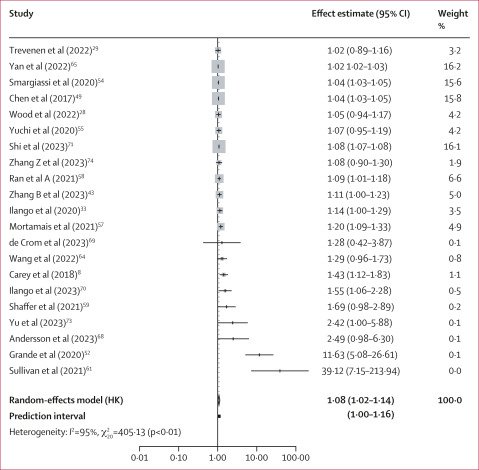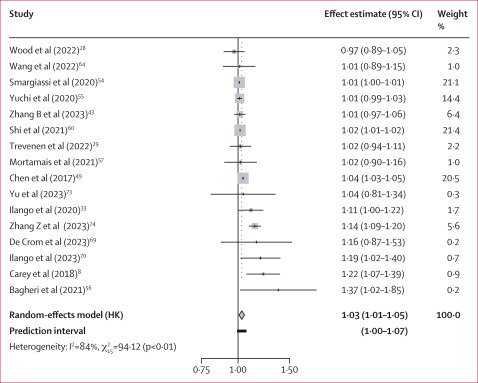The Lancet: Long-term air pollution exposure & incident dementia
Background
A rapidly evolving evidence base suggests that exposure to outdoor air pollution is a risk factor for the onset of dementia, with an upturn in publications since 2022. We sought to synthesise and critically assess this evidence base accounting for the latest studies.
Methods
In this systematic review and meta-analysis, we searched MEDLINE, Embase, Cochrane Library, CINAHL, Global Health, PsycINFO, Scopus, and Web of Science Core Collection from database inception up to Oct 23, 2023, for primary observational studies of adults (aged ≥18 years) that provided a quantitative analysis of the association between long-term (≥1 year) exposure to outdoor air pollutants and a subsequent physician diagnosis of dementia. When three or more independent studies reported an exposure–outcome pair, effect estimates of the association were extracted and harmonised to a prespecified exposure increment, and included in inverse-variance weighted random-effects meta-analyses. Between-study inconsistency was assessed using the I2 statistic and the Cochran Q test. Study-level risk of bias and confidence in the overall body of evidence were assessed with the Office of Health Assessment and Translation tool, and publication bias was examined. The protocol for this review was registered with PROSPERO, CRD42023414413.Findings
The search generated 15 619 records, of which 51 studies met the inclusion criteria for data extraction. After excluding studies due to population overlap and missing continuous effect estimates, 32 studies reported on exposure–outcome pairs that met the threshold of three or more studies, and were included in meta-analyses of adjusted effect estimates for incident dementia and/or in subgroup analyses of dementia subtypes. In meta-analyses of incident dementia, we identified a dementia diagnosis to be significantly associated with long-term exposure to PM2·5 (21 studies, n=24 030 527, pooled adjusted hazard ratio (HR) per 5 μg/m3 increase in exposure, 1·08 [95% CI 1·02–1·14]; I2=95%), nitrogen dioxide (16 studies, n=17 228 429, pooled adjusted HR per 10 μg/m3 increase, 1·03 [1·01–1·05]; I2=84%), and black carbon/PM2·5 absorbance (six studies, n=19 421 865, pooled adjusted HR per 1 μg/m3 increase, 1·13 [1·01–1·27]; I2=97%). We found no significant association for exposure to nitrogen oxides (five studies, n=241 409, pooled adjusted HR per 10 μg/m3 increase, 1·05 [0·97–1·13]; I2=44%), PM10 (four studies, n=246 440, pooled adjusted HR per 15 μg/m3 increase, 1·52 [0·80–2·87]; I2=82%), or annual ozone (four studies, n=419 972, pooled adjusted HR per 45 μg/m3 increase, 0·82 [0·35–1·92]; I2=69%), with moderate to considerable heterogeneity between studies in these pooled analyses. Of the 32 studies overall, three (9%) had a probably high risk of bias in one of seven domains; all other studies had ratings of probably to definitely low risk of bias. The overall certainty of evidence of studies in the systematic review was moderate.
Interpretation
This analysis adds to the body of evidence that outdoor air pollutants are risk factors for dementia, indicating that reduced exposure to pollution could reduce dementia rates and stricter air quality standards would likely provide substantial health, social, and economic benefits.
Research in context
Before undertaking this study, we reviewed the existing literature as detailed in our published protocol for this study (Khreis et al. Environ Int 2022; 170: 107596). This review included summarising systematic reviews (2015–22) on long-term outdoor air pollution exposure and risk of dementia, Parkinson’s disease, multiple sclerosis, and motor neuron disease, and engaging in an review of the materials and a non-comprehensive review of the literature, including systematic reviews and meta-analyses, on the associations between various outdoor air pollutants and dementia incidence. We identified key gaps, such as little evidence on nitrogen dioxide (NO2), nitrogen oxides, and black carbon (BC)/PM2·5 absorbance, a paucity of certainty of evidence assessment, and few subgroup or sensitivity analyses to explore the sources of large observed heterogeneity. Additionally, we found that the number of relevant primary studies had markedly increased since the previous systematic review publications. We subsequently developed and published a protocol for an updated systematic review and meta-analysis, which sought to deepen the understanding of the relationship between outdoor air pollution and dementia incidence, expand analyses to additional pollutants, subgroups, and subtypes of dementia, assess study quality and certainty of evidence, address previous inconsistencies, and provide updated estimates.
Added value of this study
Drawing on 32 studies (pooled population, n=26 180 535), this meta-analysis assessed the effect of long-term (≥1 year) exposures to single outdoor air pollutants on the risk of a subsequent diagnosis of dementia and dementia subtypes. Meta-analyses of individual pollutants identified incident dementia to be significantly positively associated with long-term exposure to PM2·5, BC/PM2·5 absorbance, and NO2. Our certainty of evidence assessment indicated a moderate level of certainty across the overall body of evidence. Our risk of bias assessment indicated generally low risk of bias, although three studies that contributed adjusted effect estimates in meta-analyses had probably high risk of bias in one domain.
Random-effects meta-analysis of adjusted effect estimates for PM2·5
To our knowledge, this study provides the most comprehensive exposure-response estimates to date for use in burden of disease analyses, health impact assessments, and air quality regulation. It is the largest meta-analysis to explore the associations between air pollution and dementia incidence, covering pollutants not previously analysed. Our subgroup analyses by dementia subtype, continent, outcome ascertainment, and exposure assessment methods also provide insights into how evidence strength varies across groups, and highlighted areas for future research.
Implications of all the available evidence
Our findings reinforce and build on existing evidence that long-term exposure to outdoor air pollution is a risk factor for the onset of dementia. Reducing pollution exposure could lower dementia rates, and stricter air quality standards would likely provide substantial health, social, and economic benefits.
Random-effects meta-analysis of adjusted effect estimates for NO₂
[Source: The Lancet]



